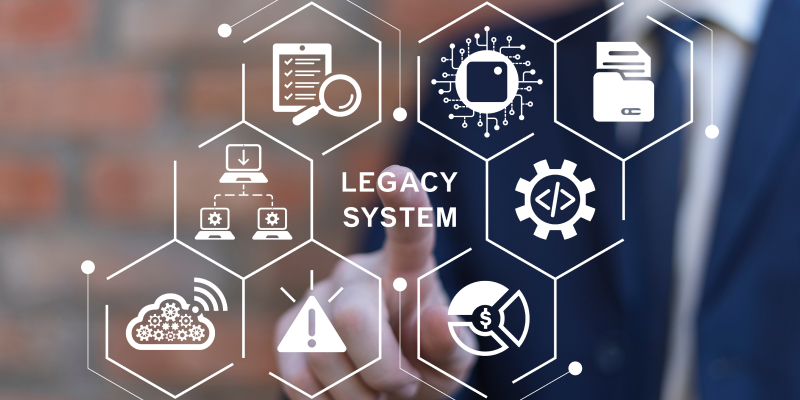Sometimes, systems can seem to work perfectly well. However, unplanned crises like hardware failure can initiate costly rush orders, leading to tremendous business disruption.
To prevent such scenarios, collaborating with the appropriate IT procurement services company guarantees that you won’t become a victim of these secret snares and assists in upgrading cost-effectively.
Failing to update incurs massive opportunity costs while inviting competitive disadvantages. Having successful IT infrastructure providers on your side minimizes these risks, brings your operations up to date, and sets the stage for scalable growth. When the systems groan and creak, it’s definitely a sign of outdated IT. These threats are conveyed into the day-to-day issues that debilitate operations.
This guide highlights the importance of recognizing critical signs of outdated IT and why ignoring them exposes your IT infrastructure to major cybersecurity risks like costly downtime and data loss.
How Does Old Hardware Affect Employee Productivity?
Outdated hardware drains employee productivity — manifesting as heightened frustration, sluggish workflows, and security vulnerabilities. These issues can lead to missed deadlines/delayed deliverables, elevated costs for IT support, and minimized overall efficiency, blocking business growth.
So, what are the business risks of using old hardware? The significant risks include:
- Increased security vulnerabilities
- Less productivity
- Rising costs
- Risk of cyberattacks
- Data loss
- System downtime
- Violations of compliance
- Compatibility issues with existing software
Ultimately, outdated technologies directly impact your bottom line. If your team complained about difficult existing systems, it’s a strong sign for an IT upgrade because your current technology holds you back.
So, how often do you face system crashes, outages, or interruptions? If frequent, it’s a major red flag. Operating painfully slow is both a sign of outdated systems and intensely frustrating.
Outdated tech erodes competitive advantage because tasks take longer. Dysfunctional workflows emerge when processes serve legacy limitations rather than business goals. Consequently, outdated constraints limit effectiveness and create obstacles.
Legacy systems slow every task, preventing the standard work pace. Slow systems cause frustration, lower motivation, and decreased job satisfaction. Outdated systems also increase security breach exposure, which we’ll examine next.
Also Read: Data Protection For Business Continuity: The Why & How Answered
Reasons to Protect Your Business From Rising Cyber Threats
Neglecting obsolete technology leaves your whole operation vulnerable to significant threats, such as cybersecurity issues. With every new security patch, threats evolve at a fast pace.
Most legacy IT infrastructures do not have basic security protections, such as:
- Multi-Factor Authentication (MFA)
- Advanced firewalls
- Active threat detection
- Automated patching
Organizations often fail to notice such vulnerabilities, or if they do notice, they undermine the risk, making them perilously exposed to advanced cyberattacks.
Cyberattacks can lead to catastrophic financial and reputational losses through data breaches. Regulations such as GDPR, HIPAA, and CCPA require up-to-date security controls. Non-compliance can lead to astronomical fines. Therefore, for your security efforts to be effective, stakeholders need to believe in your commitment. Otherwise, you end up wasting resources on doing nothing.
Also, remember that most companies seldom bounce back from major cyberattacks. Hence, adjust your risk strategy and decide whether to focus on prevention or response.
Data security issues extend beyond breaches and attacks. Data backups and recovery are also key elements in securing data. If your system has no provisions for strong backup and recovery capabilities, your business may encounter substantial threats.
If patching feels like an uphill battle, think again. IT upgrading is perhaps the best way to close security gaps and optimize protection. In that case, how often should a business replace its computers? The simplest way to check signs of outdated IT is to look at its manufacture date — if it’s more than five years old, the risk is too high, indicating it’s time for replacement.
While security is paramount, integration flaws in legacy tech also create operational hurdles, which we’ll explore next.
Bridging the Gap: Unifying Your Business With Modern Systems
If your current setup feels like a patchwork of incompatible solutions, it’s a key indicator of outdated technologies and one of the clear signs for an IT upgrade. When systems do not communicate seamlessly, it cripples efficiency and creates data silos throughout your organization.
Fragmented IT infrastructure and disjointed applications create unnecessary bottlenecks, complicate remote work, and foster frustration for both employees and customers — posing a significant collaboration hurdle.
Does your team juggle multiple disconnected tools requiring manual data entry through endless logins and spreadsheets? If so, adopting a cohesive, flexible tech stack becomes essential — it is the fundamental building block for enhanced efficiency, streamlined collaboration, and sustainable business growth.
For your business growth to thrive long-term, your core systems must integrate with modern platforms; otherwise, you’re building your strategy on sand. Understanding these integration challenges is the first step. The next section will focus on developing a strategy to overcome these operational barriers.
Strategic Planning for Your Next IT Upgrade
To plan an effective IT upgrade:
- Conduct a comprehensive technology audit that identifies infrastructure limitations and cybersecurity vulnerabilities. This assessment then informs your upgrade strategy, guaranteeing technology investments directly support Business Process Automation and operational efficiency.
- Develop a phased technology roadmap prioritizing upgrades based on risk mitigation, cost-effectiveness, and future-proofing potential.
- Focus on solutions that reduce costs while boosting productivity to ensure significant cost savings and maximum ROI.
- For streamlined execution, invest in Managed IT Services to convert capital expenditures into operational expenses.
By implementing modern systems, you enable seamless integration and scalable efficiency that drives sustainable business growth.
Transform Your Business With Future-Ready Technology
Staying technologically current isn’t optional — it’s essential for maintaining competitiveness, agility, and security in today’s digital landscape. If you notice outdated technology signs — like struggling to adopt new tools or integrate systems — it’s a clear indicator you’re falling behind and your operations need precise upgrades to survive future challenges.
You must implement modern systems that process information at lightning speed, connect seamlessly, and automate routine tasks — boosting productivity and competitive advantage by the second. Investing in the right technology upgrades plays a massive role in solving immediate problems while ensuring long-term business growth and agility.
Compare this with a proactive, planned hardware lifecycle managed by CMIT Solutions, which prevents these “time bombs” from ever going off. Instead of being caught off guard by system failures, your business benefits from a forward-looking strategy that maximizes uptime, efficiency, and security.
If you recognize these signs for an IT upgrade, why wait? Take action now to secure your business future and gain market dominance. Contact CMIT Solutions today for expert IT services in Tempe and Chandler; we’ll keep your business running smoothly while blowing away technology challenges.



